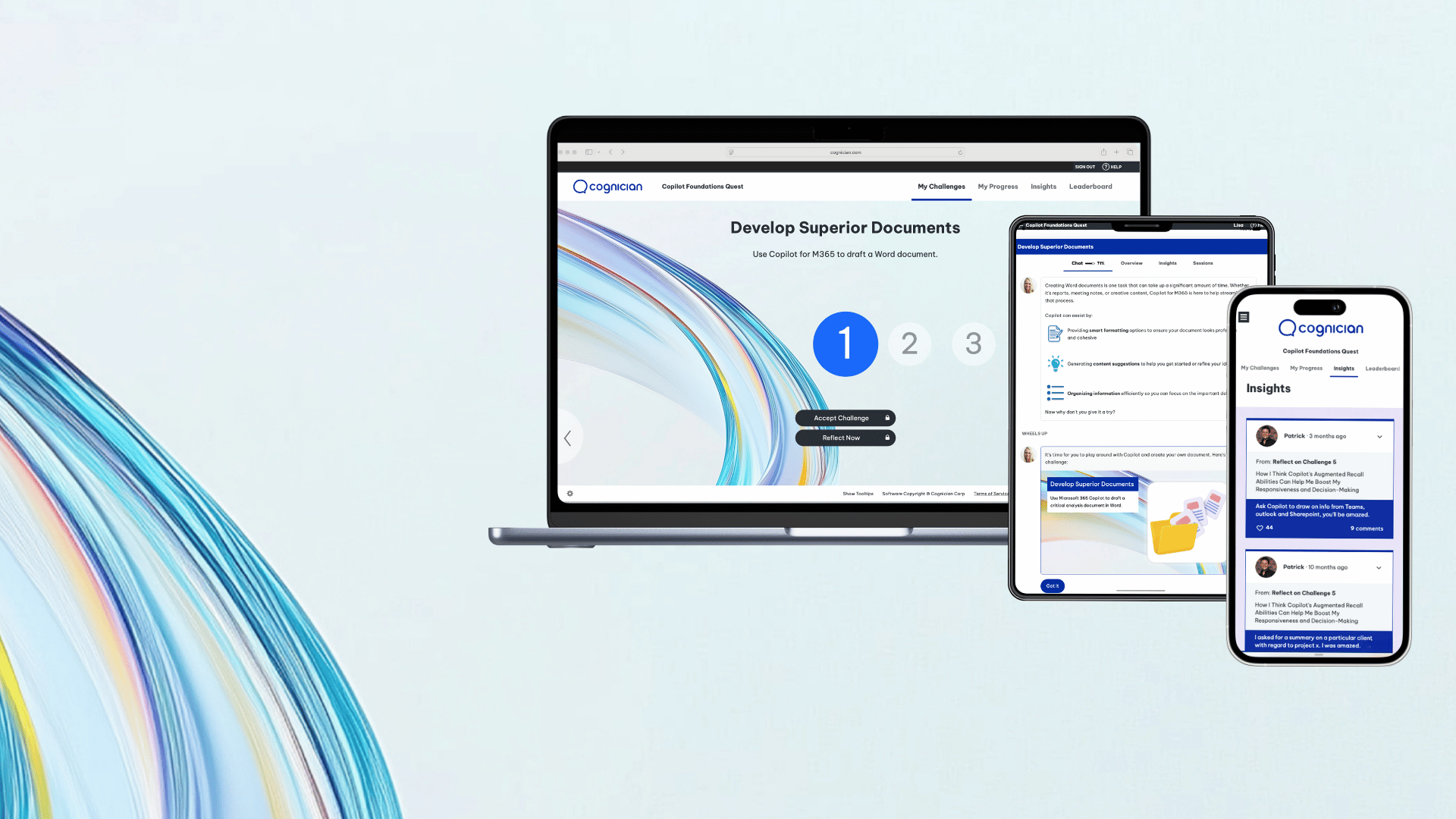Learn how to increase Copilot for Microsoft 365 adoption through practical guidance, real-world examples, and fostering a community of practice.
"Sounds fantastic. But how do I make it work?"
For many people – myself included – this is the first question when faced with Microsoft Copilot.
We've heard so much about Copilot and how amazing it is, but it still feels unfamiliar. Unlike simply asking questions in ChatGPT or other generative AI (Gen AI) tools, Copilot is embedded within various Microsoft 365 products, which makes it distinct. At first, using it can feel counterintuitive.
Naturally, businesses want to see a return on their investment in Microsoft Copilot. But the discomfort we may feel when we first start using it underlies one of the biggest problems facing a recent client of ours: the low adoption of Copilot by their employees.
Why the Problem Exists
The introduction of Copilot for Microsoft 365 promises to revolutionize workflows, yet for our client adoption was slow.
Introducing AI-powered tools requires a mindset shift, but achieving that shift without the right approach can be challenging. Many organizations invest in costly communication campaigns, workshops, training, prompt libraries, and communities of practice – often with limited ROI. Without a true change in habits, employees tend to revert to their comfort zones, preventing new systems from becoming fully integrated into existing workflows.
There are several reasons for Copilot's slow uptake, which Microsoft itself has documented. For one, many users already have well-established workflows. Changing these routines to incorporate Copilot often feels like an extra burden – especially when competing priorities fill their to-do lists.
Another key challenge is demonstrating Copilot's tangible benefits. If employees don't clearly see how it enhances their daily tasks, they're unlikely to use it.
Microsoft also highlights common concerns among employees: some fear that Copilot will replace their jobs, while others see it as too complex or simply a flashy tool with no real value.
But beyond these challenges and misconceptions, there is likely a deeper issue at play: the way we learn and embrace new concepts and behaviors.
A Learning Theory Perspective
Lev Vygotsky was a psychologist who studied how learning takes place. He introduced the concept of the zone of proximal development, laying the foundation for scaffolding theory in learning.
Vygotsky believed that learning is fundamentally a social process. For us to learn, we must engage with those who know more than us (think teachers or mentors). In this way, we gain valuable knowledge, skills, and experience that we might otherwise be unable to achieve on our own. Put simply, we can achieve more with input from knowledgeable experts than we can when working alone.
The zone of proximal development (ZPD) represents the area where we feel most confident in our learning abilities. When we step outside this zone, we may experience doubt or hesitation. To help learners overcome these challenges, Vygotsky introduced the idea of providing a supportive framework. This approach builds on learners' existing knowledge or experience – their ZPD – and gradually expands their knowledge and capabilities. By breaking tasks into smaller, more manageable steps and receiving guidance from instructors or mentors, learners can progressively expand their ZPD and strengthen their skills.
This resonates with me. We need to first build a foundational framework – an understanding of how something works – before we can add our own ideas or innovations. Without this framework, or 'skeleton,' there's no structure to 'hang' new knowledge on. Instead, information or knowledge exists in isolated patches, and we struggle to see how everything fits together. But once we have a framework, or scaffold (as it's often called in learning theory), we can begin to make sense of new concepts and expand our understanding.
We can only build a scaffold with the help or input of others. By learning from those with more knowledge or experience, we can expand on what we already know and take the next steps in our learning journey. The scaffold grows as we receive guidance, helping us build confidence. Eventually, with enough support, we reach a point where we can not only work independently but even invent our own methods.
The key to encouraging people to adopt any new technology, including Gen AI tools like Microsoft Copilot, is to help them build their comfort level through manageable actions and guidance from more experienced users.
How to Successfully Drive Copilot Adoption
A client of ours purchased 20,000 Microsoft Copilot licenses but was concerned that not many employees were using Copilot.
In partnership with a global consulting firm, we created and deployed a program to drive Copilot adoption, achieving a 475% increase in Copilot usage in 16 days. During the program, participants collectively saved 20,000 hours, proving that practical solutions can significantly boost Copilot adoption.
Here are some of the solutions that contributed to increased adoption:
- Providing practical – not just technical – support: We focused on offering initial guidance that made using Copilot accessible from the start.
- Connecting Copilot to real-life use cases: By using real workplace prompts and examples, we demonstrated how Copilot could be applied to actual workplace scenarios. These prompts were usable and spoke directly to the needs of the participants.
- Demystifying the technology using real-world examples: By showing concrete applications and tangible benefits, we made Copilot more relatable and easier to integrate into daily tasks.
- Creating opportunities for hands-on practice: We allowed participants to experiment with Copilot in ways that didn't disrupt their usual workflow, making it easier to adopt.
- Building a company-relevant dynamic prompt library: We developed a continually updated, easily accessible resource of company-specific Copilot prompts. This library evolved based on community feedback and evolving use cases.
- Establishing a community of practice: We created a support network within the organization where employees could share experiences, ask questions, and collaborate on solutions.
These solutions align closely with Vygotsky's idea of creating a scaffold for people to build upon, providing employees with the necessary support to build their knowledge and confidence. And the best part? They're not overly complex to implement.
But there's a potential challenge with scaling some of these strategies. Vygotsky emphasizes the importance of teachers or mentors to guide individuals. How do you provide this level of mentorship for 20,000 people? How do you effectively deliver and communicate these solutions on such a large scale?
How We Do This at Cognician
Cognician has a unique approach to address this problem. We create online employee activation programs that leverage a coaching methodology to activate and facilitate behavior change.
Our programs feature coaching guides – referred to as 'cogs' – that engage participants in a chat-based, coaching-like experience designed to drive behavior change and improve productivity. These bite-sized coaching guides require only a few minutes of a participant's time.
The focus is on enabling participants to experiment with real-world actions while receiving immediate support and feedback. Each cog is crafted to provide just the right amount of guidance to enable participants to take manageable actions – in Vygotsky's terms, providing scaffolding. These actions manifest as offline activities or 'challenges' that participants complete between online sessions.
For the Copilot adoption program, we designed the challenges around real use cases. Participants received actionable prompts to try and were guided with videos demonstrating how to navigate Copilot within various Microsoft 365 applications. They conducted small 'experiments' outside their comfort zones to raise awareness of Copilot's possibilities.
After completing each challenge, participants engaged in online reflections on their action-based learning. Through these reflections, participants were invited to share their insights with their peers in their learning community. One notable feature of our programs is that participants can 'like' and comment on the insights shared, which adds a social layer to the learning experience. This peer interaction fosters group cohesion and enhances learning.
We were pleasantly surprised by how enthusiastically participants embraced the social aspect of sharing and commenting on insights. They began spontaneously helping each other out by commenting and offering guidance and support when their peers shared their struggles.
Key Takeaways
Driving the adoption of any new technology within an organization is not merely about informing people of its existence and expecting them to figure it out. It requires a commitment to changing habits and providing continuous support.
The same applies to Microsoft Copilot. By focusing on practical guidance, offering real-world examples, and creating opportunities for users to engage with the technology (followed by reflection on their experiences), we can activate new behaviors and habits.
Fostering a strong community of practice ensures that employees are not only equipped with the necessary knowledge but also supported as they navigate this new technology, ultimately setting them up for long-term success.



.png)

